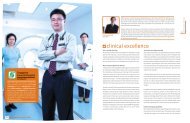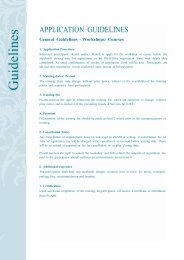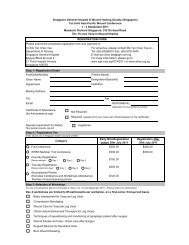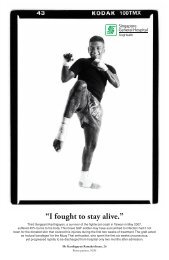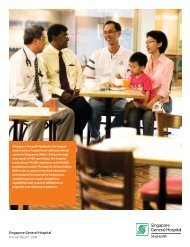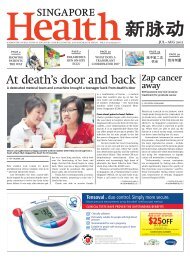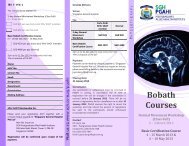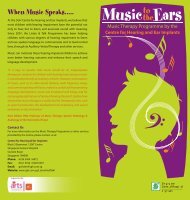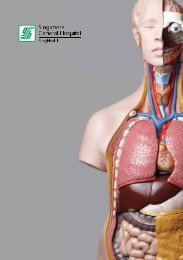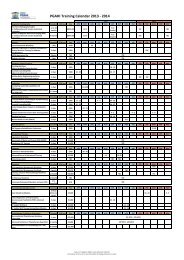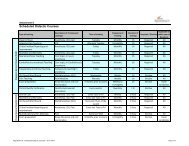(bcls) programme - Singapore General Hospital
(bcls) programme - Singapore General Hospital
(bcls) programme - Singapore General Hospital
Create successful ePaper yourself
Turn your PDF publications into a flip-book with our unique Google optimized e-Paper software.
INFANT CPR<br />
STEPS<br />
D : Danger<br />
ACTION<br />
Look out for unsafe environment, e.g. Electrical current, Fire, Possible<br />
Explosion, Construction works, or Poisonous gas<br />
• Ensure that the scene is safe for you to help<br />
R : Response Establish unresponsiveness :<br />
• Call, tap or gently shake the infant’s shoulder to elicit response<br />
• If you are alone, immediately start CPR 30:2 for approx. 2 minutes<br />
S : Shout for Help • If a second rescuer is present, ask him or her to call for ambulance 995<br />
A : Airway<br />
B : Breathing<br />
C : Circulation<br />
Open airway : Head Tilt-Chin Lift<br />
Check for normal breathing : Look, Listen, & Feel (up to 10 seconds)<br />
Look for the rise and fall of the chest<br />
Listen for air escaping during exhalation<br />
Feel for the flow of air from the infant’s mouth and nose moving past your cheeks<br />
Check for brachial pulse up to 10 seconds (only for Healthcare providers)<br />
If pulse is absent (if unsure of pulse and infant has no breathing, assume cardiac arrest),<br />
start 30:2<br />
For laypersons, there is no need to check for pulse. If infant has no breathing, start CPR<br />
Locate landmark for chest compression:<br />
• Draw an imaginary line between nipples<br />
• Place index finger on the imaginary line<br />
• Place your middle and ring fingers next to the index finger<br />
• Move the 3 fingers to the centre of the sternum (breastbone)<br />
• Position the fingers upright<br />
• Lift off the index finger but maintain the middle and ring fingers contact on the<br />
sternum (breastbone)<br />
• Lean forward and place your cheek near the infant’s mouth and nose<br />
• Use your middle and ring fingers to compress the sternum (breastbone) by 4 cm<br />
Demonstrate correct technique of compression<br />
Keep fingers contact on the sternum during each upstroke<br />
Say mnemonic<br />
“1&2&3&4&5&1&2&3&4&10&1&2&3&4&15 1&2&3&4&20<br />
1&2&3&4&25 1&2&3&4&30”<br />
Compression rate is at least 100 per minute<br />
CPR Cycle • Perform 5 cycles of 30 chest compressions followed by 2 breaths for approximately 2<br />
minutes (For Healthcare providers only)<br />
• The duration for each breath is 1 second.<br />
• Ventilation volume is between 30 ml/breath<br />
• Allow lung deflation between each breath<br />
Reassessment<br />
• Assess for pulse and breathing after every 5 cycles of CPR 30:2 (for healthcare providers<br />
only)<br />
• If pulse is absent (if unsure of pulse and infant is not breathing, assume cardiac arrest),<br />
continue CPR 30:2<br />
• For laypersons, continue performing CPR until help arrives or infant starts moving<br />
Recovery Position • Recovery Position Place the infant in the recovery position if :<br />
• Pulse and breathing are present<br />
• Infant is unconscious and has no evidence of trauma<br />
• Continue to monitor infant’s pulse & breathing every few minutes as this can stop<br />
suddenly<br />
BCLS Programme<br />
49



![help document [pdf]](https://img.yumpu.com/26291587/1/190x245/help-document-pdf.jpg?quality=85)
